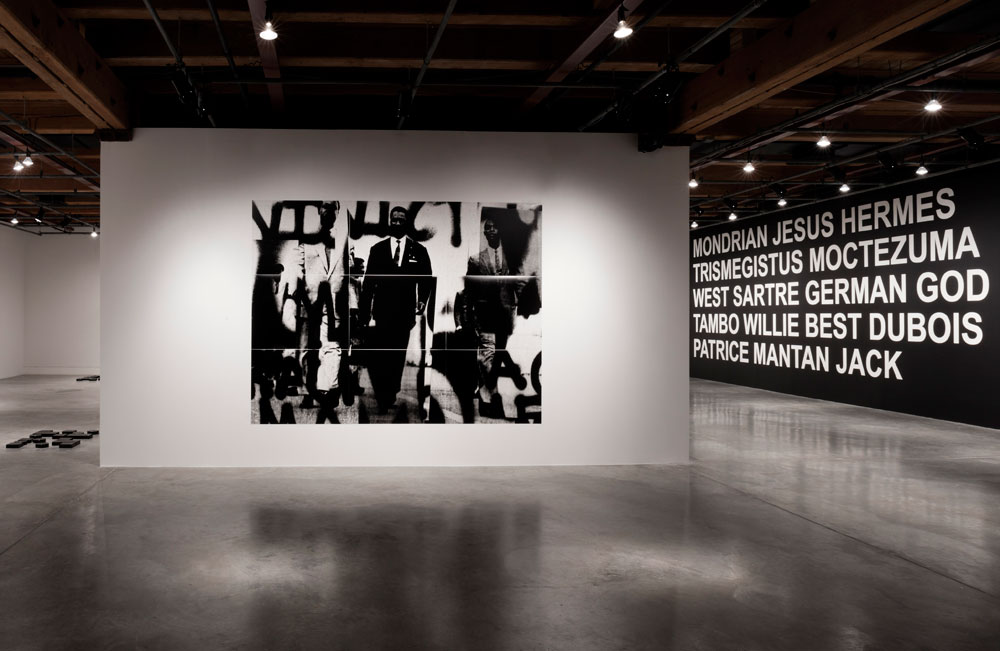Adam Pendleton
Contemporary Arts Center, New Orleans, USA
Contemporary Arts Center, New Orleans, USA

The appropriated imagery in Adam Pendleton’s show at Contemporary Arts Center, ‘Becoming Imperceptible’, ranges from photographs of Congolese independence celebrations in 1960 and the country’s martyred politician Patrice Lumumba to reproduced fragments of African artworks that were incorporated into Bauhaus designs, depictions of dada choreography and footage from French new wave films. The exhibition features 43 discrete works that are incorporated into larger, room-sized collages and wall installations; although they were all made in the past five years, many integrate themes and images from Pendleton’s earliest works.

The maximal installation – in which the walls are densely hung with posters, collaged images and texts while individual silkscreen-on-Mylar and Plexiglas constructions fill the space – denies the viewer any visual respite. In his 2014 series of silkscreen-on-mirror works, ‘Untitled (water)’, Pendleton alters photographs Josef Albers took in 1929 of the undulating surface of water. In his use of mirrored surfaces and fragmented lettering, Pendleton presents split subjects, approaching what dada poet Hugo Ball called the ‘self-disintegration’ that often accompanies the rending of symbolic forms.

The artist’s series of large, monochromatic paintings, ‘Black Dada/Column’ (2015–16), features details cropped from Sol LeWitt’s 1974 installation Incomplete Open Cubes overlaid with individual letters from the series title. These abstract black paintings seemingly seek to subvert reductive preconceptions that all work made by black artists is informed by ‘blackness’ in some way. By harking back to models of process art from earlier decades, Pendleton’s gambit is that alteration of such work can help confute entrenched notions about the relationship between race and representation. Elsewhere, Pendleton’s groupings of small, black and white, semaphore-shaped ceramic sculptures draw their forms from the signs in Hannah Weiner’s Code Poems (1982). Composed using the International Code of Signals – a 19th-century system for ships signalling at sea – Weiner’s poem includes glitch-like square forms that do not appear in the original cipher. In his own, further appropriation, Pendleton hints at how systemic codes can be disrupted, re-iterated and reprised to better ends – implying, by extension, that social mores and conventions can be interrupted, renegotiated and re-instated in a similar fashion.

Pendleton’s works pose problems not solutions; they multiply perspectives rather than offer a sole thesis. For example, in his three-channel video installation My Education: A Portrait of David Hilliard (2011–14), Pendleton presents multiple perspectives on the 1968 shootout between Oakland police and members of the Black Panther Party. References to present-day struggles are similarly multivalent. In Black Lives Matter #3 (2015), the infamous ‘Black Lives Matter’ slogan opposing police violence, here abstracted beyond recognition, stretches across one gallery wall. The work includes key quotes from poet LeRoi Jones’s ‘Black Dada Nihlismus’ (1964) – not, it is worth noting, from his later poems, written as Amiri Baraka, which took aim at capitalism rather than simply white supremacy – while excerpts from Pendleton’s own text ‘Black Dada Manifesto’ (2008) also appear fragmented along a gallery wall.

Pendleton’s exhibition takes its title from the work of the French philosophers Gilles Deleuze and Félix Guattari, whose theory of ‘becoming imperceptible’ is often invoked as a strategy of resistance to a society of surveillance and control. Pendleton appears to employ it in its broader sense, however, to indicate a ‘becoming other’. By removing texts from their original context, and abstracting them often beyond legibility, the artist explores imperceptibility as potentially liberating, freeing space for self-definition. For Deleuze and Guattari, the expression ‘becoming imperceptible’ refers to a slow, sometimes dangerous, transformation into different states of being. In such a context, Pendleton’s exploration of the way ideas, moments and periods are networked casts history in a new light, and opens up alternative visions for the future.
























